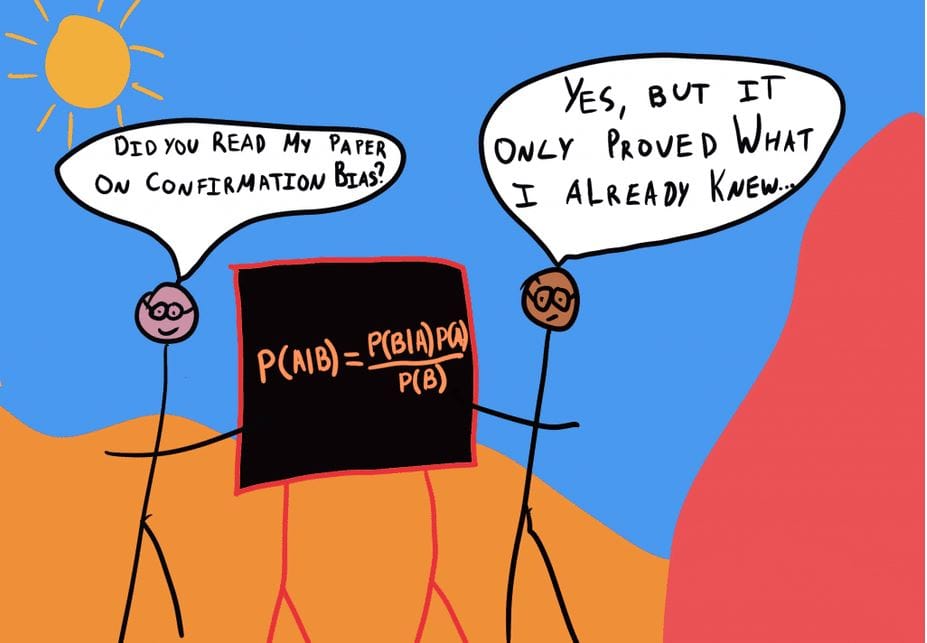Confirmation Bias & Reality

Recently, I heard from my friend, Ann, a story relative to one of her college experiences at Brigham Young University–Idaho. In a class devoted to political discussion and social science, she came face-to-face with a young man who insisted that systemic racism, or any kind of racism for that matter, was not a significant feature of American culture. This young man’s debates with the rest of his classmates regularly became intense, heated, and depredatory. On one occasion, Ann and her partners presented a group project on how systemic racism has impacted inner-city communities in terms of childcare and foster systems. This young man, assigned as one of the project’s peer graders, gave Ann and her team a score of 10%. Ann, seeking to understand the underlying motives behind the low score, reached out to this young man and asked the reason for the 10% grade. His response was consistent with his previous behavior: “The project conveyed inaccurate information about the prevalence of racism and falsely suggested the existence of systemic racism in America.” During his own presentation, this same young man suggested that the infamous Adolf Hitler did nothing wrong in organizing a holocaust, and that his crusade against the Jews during the mid-1900s was the result of a genuine desire to protect Germany from a legitimate threat.
Ann’s story is not unlike many other stories. The young man to whom she referred comes from a small town in Idaho. Idaho is, of course, a predominantly conservative state. 93% of the populace is white, and only 27% have an education degree exceeding high school. The population is scattered throughout the state sufficient to provide an average of nineteen people per square mile, and is mostly agrarian in its industry. It is, therefore, not surprising that a young man, born and raised in Idaho, and attending a private university which has intricate cultural ties to Utah and Idaho, should have strong feelings on the subject of racism and systemic racism specifically. From his point of view, systemic racism does not exist. There simply is not enough racial diversity within Idaho to adequately or accurately inform him on the subject as it pertains to a national scale.
The young man’s perspective Ann described in her story is an example of confirmation bias. The question of where beliefs and knowledge come from has been a subject of philosophical musing since the time of Plato. One common understanding of knowledge’s source, however, is experience. Knowledge is experiential, or in other words, human beings learn from their experiences. These experiences inform not just beliefs but worldviews. From this experience-belief-knowledge paradigm is born confirmation bias, which describes the tendency of anyone to view the world through the lens of his or her own experience and knowledge.
As the above example indicates, confirmation bias is common in political and social commentary but is not unique to those spheres. Religion has also proven to be fertile soil for the diffusion of confirmation bias; for example, many American Christian religions see technological advances as heralds of the millennial era. When sending the first telegram, Samuel Morse tapped out the code-signal for the phrase “what hath God wrought,” indicating his belief that God was the driving force in the technological innovations which would go on to secure America’s future as a world power. The response of the American public in private and practice affirmed that notion. Beyond that, America’s religious experience was always characterized by its millennialism undertones and generally diffused belief that America was “the country where God would bring his plan for humanity to fulfillment [. . .] an example and harbinger of popular government to the rest of the world.” Today, many American Christians still seek to match the signs of the Second Coming of Jesus Christ to current events.
Confirmation bias can be found everywhere - in religion, in politics, in philosophy, and even in more concrete, scientific fields. There is nothing inherently wrong with confirmation bias or bias in general. Historians are well-trained to examine biases in the sources they examine, which can inform them of the intentions of the people who authored those sources. Those biases inherent in historical sources do not detract from the source itself, but awareness of how the author’s worldview might have affected his writing is essential.
All things possess a certain amount of bias to them because all things are ultimately the creations or interpretations of people, who are in turn informed and shaped by their experiences. Confirmation bias only becomes an issue when it blinds to the realities of other people, when it leads people to disengage with their natural empathy, and when it stirs to contention. For example, I have seen, in my own social networks, how the confirmation bias of many members of my own faith leads them to call the doctrines of organizations with opposing political beliefs “evil.” The tendency to compare those organizations to secret combinations dedicated to the overthrow of the government (as portrayed in the Book of Mormon, a major religious text of my faith) is almost overwhelming and impedes honest civil discourse between partisan groups. And, of course, Ann’s story and others like it indicate that confirmation bias can create dangerous ideas about the reality of poverty, discrimination, and outright hatred faced by minority groups in the United States. This is an issue not only when discussing racism but also when discussing gender equality, LGBTQ rights, economic disparity, and religious liberty. Even if one has determined to stand his or her ground on one of these subjects, honest discourse requires a degree of honesty and empathy from everyone. Confirmation bias must be addressed on an individual basis in order to have legitimate conversation.
One way for an individual to initiate this transition is to change the way he or she consumes information. Many people are prone to use deduction, or the scientific method, when learning. This is a top-down approach where an idea, or hypothesis, is conceived and developed and then tested. This is a poor method for learning about social and political issues. In the deductive method, the hypothesis is changed if the data does not support it. This method is, as its name suggests, useful in the hard sciences. However, using the deductive method of learning when dealing with socio-political issues opens the door wide for confirmation bias to enter the door—through the extensive material provided by the media, smart phones, and other technologies that facilitate rapid connection and transfer of information as events unfold—and “fudge” the data so it appears a hypothesis was correct. In other words, someone like Ann’s classmate could develop a hypothesis that systemic racism does not exist in America (based on the one part of the story he experiences as an Idahoan), and then cite examples of successful people of color like Candace Owens (who is a through-and-through, by the bootstraps conservative who consistently denies the widespread existence of systemic racism) while—deliberately or not—ignoring the millions of others who suffer from the influence of systemic racism. To conservatives, Candace Owens is the exemplar of the Black community. But her views do not necessarily reflect the feelings of other African Americans in the United States.
A better approach, then, to dealing with confirmation bias is to use inductive reasoning. This is the method used by historians to perform studies which vary in nature between longitudinal and case. In inductive reasoning disciplines, sources from all sides, all walks of life (whether legitimate or dubious) are examined in order to accurately paint a broader, deeper representative portrait of reality. This entails researching conservative, liberal, and independent news sites and stories; considering both the examples of racially ideological exceptions - or outliers - like Candace Owens as well as the plight of the masses; comparing the data of all of these things together and contrasting them against each other; organizing those thoughts in a manner which most accurately paints the portrait (usually done through writing, which presents a wonderful opportunity to see, in visible format, the intricate interactions of facts and data); and presenting that for honest, oftentimes humiliating, evaluation to the public, leading to continual reflection on the subject by the author.
The inductive method takes time, of course. In the case of Ann’s story, the young man could look into cases of African Americans around the country, particularly in urban areas, and how they experience, for example, the justice system, stereotypes, and economic fetters. Such research, of course, is the first step to much-needed empathy which will help heal the world. Empathy requires honest self-analysis, effort, and time. But, after all, if one is not willing to take the time to learn and understand, one should not take the time to speak either.
About the Author: Zachary Beyler is from Chicago, Illinois. He is a student at Brigham Young University-Idaho majoring in Educational Psychology with a content emphasis in history and government. He enjoys all outdoor activities except running, which he considers to be “exhausting” and “pointless.”
